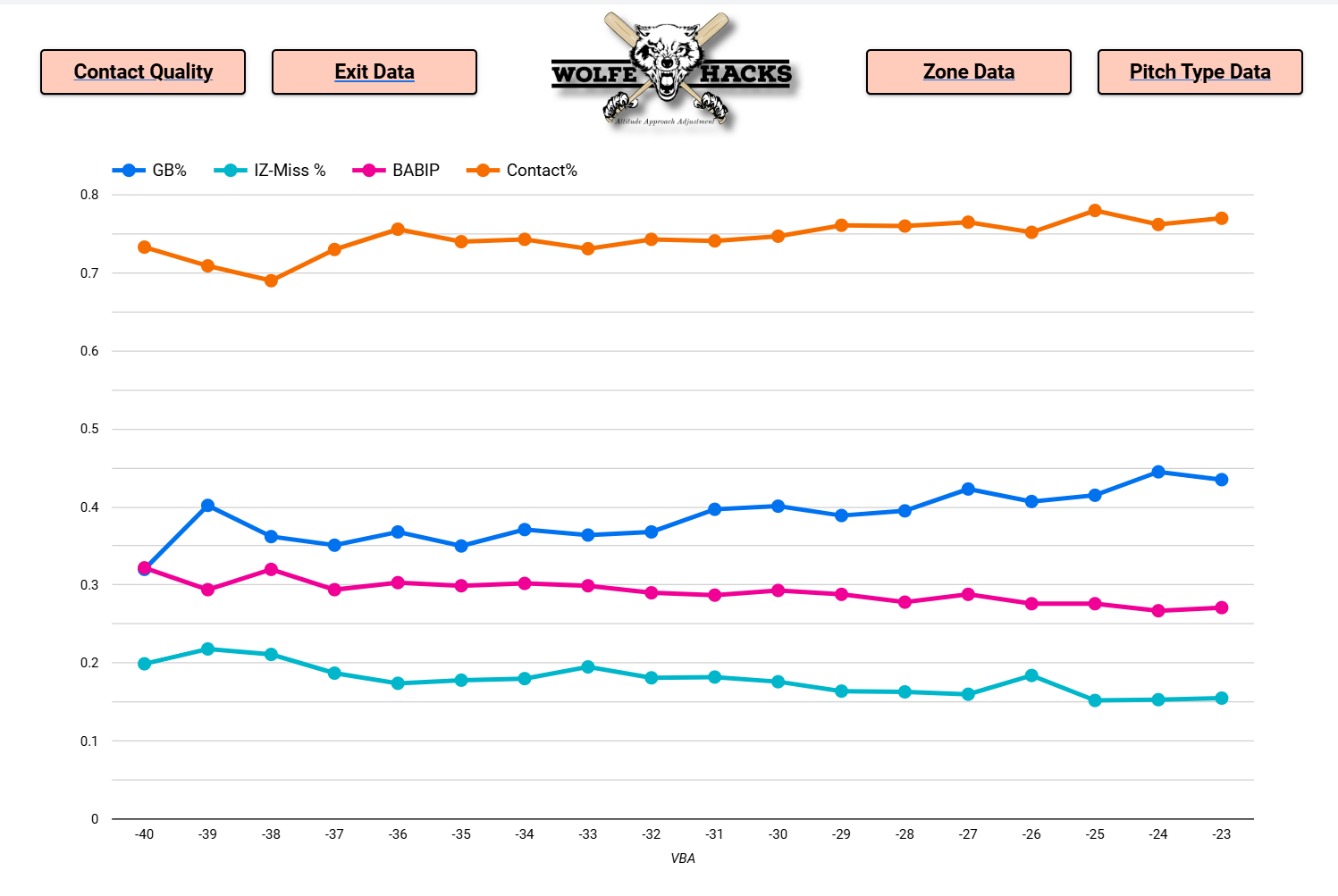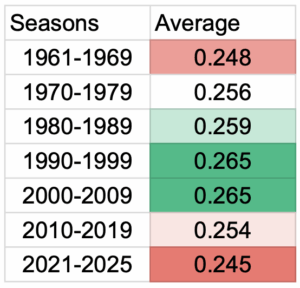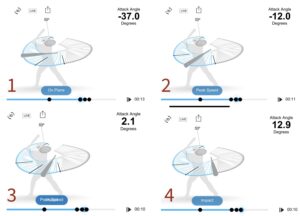Written by: Tyler Wolfe
This blog is more of a follow up to my post: Vertical Bat Angle: A New Way to Look at Batter vs. Pitcher Matchups that you can find here: Vertical Bat Angle: A New Way to Look at Batter vs. Pitcher Matchups. That post just talks about Vertical Bat Angle (VBA) and how every hitter has a different style which gives us some insight into why certain hitters may hit certain pitches or locations better than others. It also explains why sometimes the belief of sending a lefty pinch hitter up to face a righty pitcher may not always be the best option.
In this blog I wanted to go more in depth into VBA and bucket guys strictly based on their average VBA and determine what trends may stand out when we look at the in-game data. Of course hitting is ever changing and no two swings that the same hitter takes are ever exactly the same due to the complexity of the task of hitting a baseball. However, I still think that understanding this data helps us as coaches gain more insight as to how to best help a hitter, whether that be a swing adjustment or implementing a better approach in the box. The reason I continue to do research like this is to either help validate, or to help to disprove, my beliefs on certain ideas when it comes to hitting. Hitting is such a difficult skill and I believe we know very little about it. So every new piece of information such as this only helps us get closer to understanding how to help coach each hitter more efficiently and effectively.
So let’s start with the research I was able to pull (All of the VBA data is from SwingGraphs and the in-game data is from Baseball Savant, TruMedia, & FanGraphs). Before we dive in here’s a couple notes on the data:
- 1. The data is all for players with at least 10 major league at bats this year.
- 2. This table below is how many players fall under each one of the Average VBA’s:
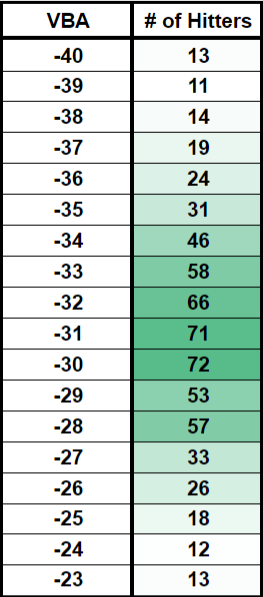
Most interesting finds from the research I will talk more about:
- Contact rate much higher in flatter bat path’s
- BABIP much higher in the more vertical VBA’s
- VBA between -32 and -35 has the most success against all pitch types
- As expected, steep VBA’s cover down and closer best & Flatter VBA’s cover the top best
1. Contact rate much higher in flatter bat path’s.
Below this paragraph is a table of contact quality between all of the VBA’s. One thing to note, I always prefer to look at In-Zone Miss% rather than overall Miss% because pitches in the zone are the ones that ultimately matter for contact. What stands out the most: Hitters with Flatter VBA’s (in the mid to upper 20’s for average VBA) have significantly higher contact rates on average. I know this hurts many people to hear, but strikeouts are not the worst thing in the world in this game (yes, certain times they hurt us but there are also certain times they’re actually better than other results) but the leading cause of strikeouts is swing and miss and not chase. Chase just tends to lead to less walks. So as we can see by this data VBA is a pretty significant factor for the majority of guys when it comes to the basic principle of making contact and putting a ball in play. When you add in foul ball rates to the contact numbers the flatter group puts even more balls in play than the steeper VBA’s. This this leads us right into the second interesting note I found:
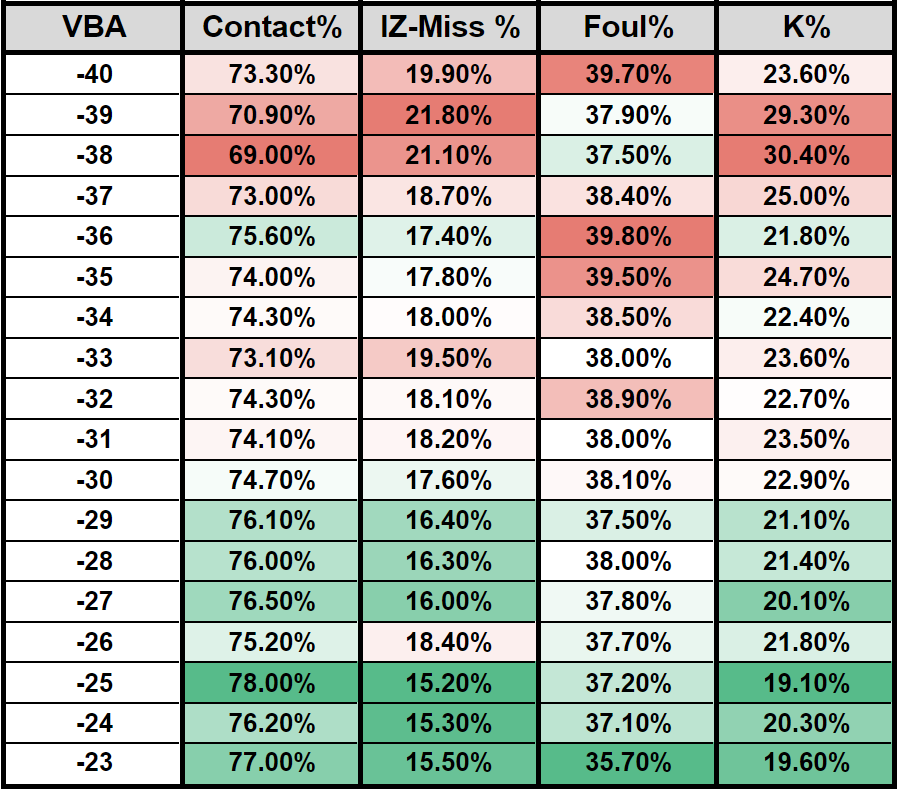
2. BABIP is much higher in the more vertical VBA’s.
BABIP is Batting Average on Balls in Play. The BABIP table is below. When looking at the data we clearly see a significant reversal of the contact data. The guys with the steeper VBA’s tend to have much more success when they do put the ball in play. The top 6 groups of VBA (-40 to -35) have an average BABIP of .306 versus the bottom 6 groups in VBA (-28 to -23) have an average BABIP of .276. So let’s dive a little deeper into that.
One strong correlation to BABIP appears to be the Ground Ball % and average launch angle. The steeper VBA’s (-35>) have a significantly lower ground ball rate than the flatter VBA group. Nearly 10% from the two opposite ends. When we flip to the average launch angle we see a slight difference with the steeper VBA’s getting the ball slightly higher on average, but not as substantial of a difference as the ground ball rates. When we take it a step further, the flatter VBA hitters tend to have a slightly higher max exit velocity, but when it comes to average exit velocity there is not a significant change throughout. This is likely due to the contact/foul ball rate seen above. The flatter group is likely a creating path that allows for more balls to be put in play deeper (or more out front) in the zone where there is likely softer contact on these particular swings which help even out the average exit velocities we see. This, in my opinion is why we see the large gap in max exit velocities but not in the average exit velocities.
- Speed/Exit Velocity notes: hitting and pitching are rotational movements to an extent. Pitchers want to throw close to the plane of the shoulders with their arm action for both speed, sequencing, and health reasons. We see this same thing with the swing, the swing tends to be parallel to the plane of the shoulders at contact. So in order for many guys to have a 40 degree VBA you would need to be at a spine angle (leaned over home plate at nearly that same angle and rotate on that plane) which is not an easy thing to do especially when swinging close to max effort. So many of the hitters with the stepper VBA’s we see where the body tilt and the path may not be as perfect as with some of the flatter paths. This to me is why we do see the higher EV’s with the flatter swings because they can create this speed a little more efficiently. I’ve seen this a lot with bat speed work I’ve done hitters where their path starts to flatten out slightly as speed goes up.
With all of the data I went through, it seems like the groundball percent appears to have the greatest impact on the outcome of the BABIP in regards to VBA. And of course, xwOBAcon was nearly an identical trend to the BABIP for those that love the advanced stats. For the sake of the article and possibly a broader audience, I thought BABIP made the most sense.
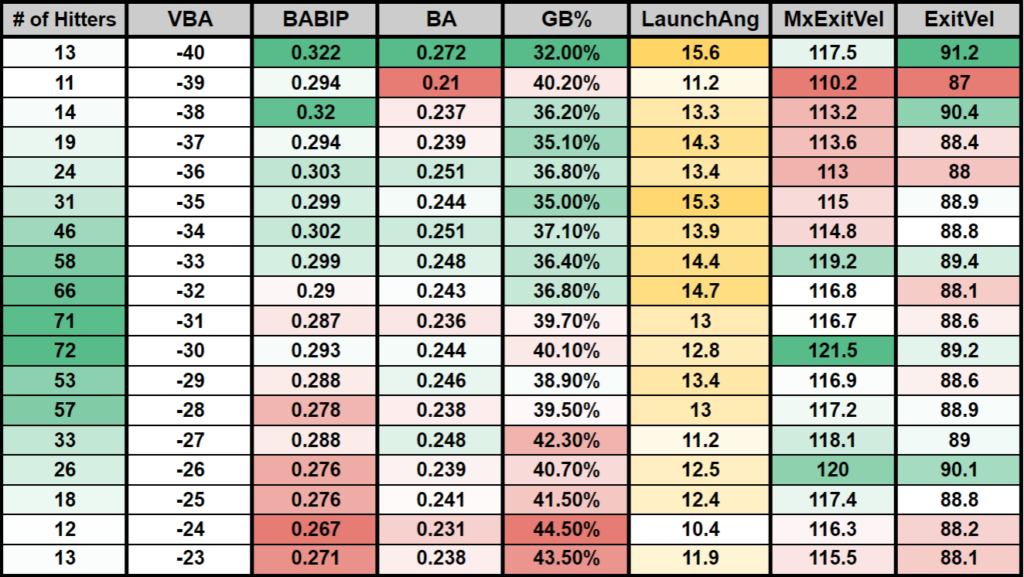
3. VBA between -32 and -35 has the most success against all pitch types.
As you can see in the table below when going across horizontally under each VBA you can see that there is far more average to above success in the middle ranges of VBA. One note: the majority of the plate appearances in the -40 degrees of VBA group is Aaron Judge, which is a big reason for those numbers all showing up green at the top. The middle, or average VBA’s where the majority of hitters fall and makes the most sense for covering multiple pitch types the best due to that -32 to -36 VBA likely putting their barrel close to the middle of the plate on average. This means the adjustment to get to the top or bottom of the zone from that position is smaller so they don’t have to try to alter the path direction as much keeping everything a little cleaner through contact.
As a side note, I also did another copy of all of my research by taking the ratio of VBA/height of each hitter in inches and then multiplied that by 73 (6’1”) which is the average height of a major league position player. I did this to take a deeper dive into zone locations and pitch types but ended up with very similar numbers across the board. An example of this was Aaron Judge went from a -40 VBA at his 6’7” height to a -37 VBA if he were 6’1” as far as where his barrel would end up in the zone. Steven Kwan went from a -35 VBA at his 5’9 height to a -37 VBA when changed to 6’1″ putting them both in the same bucket of hitters. Like I just mentioned, the data still came out very similar where the -32 to -35 degree range still on average had the most success across the board.
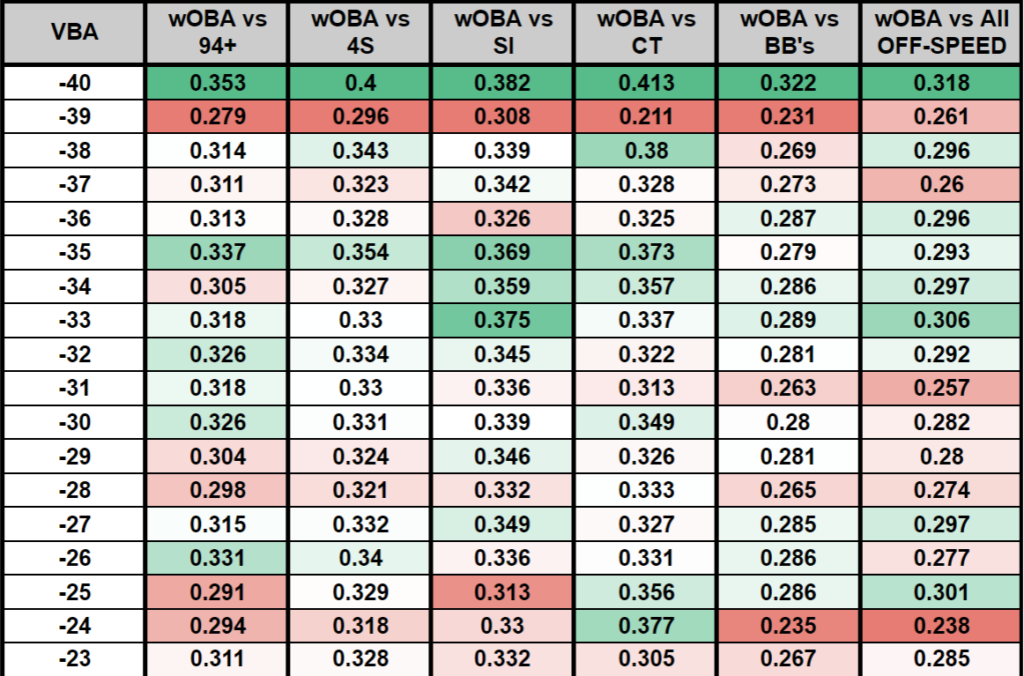
4. As expected, steep VBA’s cover down and closer best & Flatter VBA’s cover the top best
If we take out the extremes, the -39,-40, -23, & -24, we see that the success in the vertical halves of the zone are what we’d expect (table below section). The steeper VBA has more success in the lower half and the flatter VBA’s have more success up on average. This is also true when looking at the inner half as well as we see far more success in there from the steeper VBA hitters. This matches up well with what VBA data in the past has told us. Flatter VBA’s have much more success in the upper half of the zone, primarily against the 4-seam fastballs where the steeper VBA’s have an easier time with all the pitch types in the lower part of the zone.
My big takeaways as a hitting coach: flatter VBA swing means a hitter should be able to cover the upper portion and stuff away from him a little easier, while stuff inside and down will give him more issues. Generally the reason stuff down gives hitters with flatter paths trouble is this is where many of the ground ball swings happen because something is limiting them from getting down to get under that specific pitch, therefore there is going to be lower BABIP results simply due to this reason. On the flip side the steeper VBA path’s will, more often than not, cover the bottom half of the zone and the inner half of the zone much better. Both make logical sense when thinking about the angles of the bats versus the incoming pitches in those locations. The fastballs at the top give these hitters trouble because they tend to work from under the ball so the flatter the pitch (more parallel to ground level) the harder it is for them to get up to or on top of.
The hitters I tend to see with good contact rates with the high VBA’s seem to be extremely good at getting their hands above the ball so that the barrel can still fall into the plane of the pitch. The hitters with steeper VBA’s that swing and miss a lot at these pitches best hope for the fastball up is to catch it farther out front when the barrel starts working up and through the pitch. This just leaves a smaller window for quality contact up there which is why steep VBA hitters do not handle those FB’s as well. But on the other hand when any other pitch with a much more downhill action or steeper Vertical Approach Angle (sinkers or any off-speed) the more vertical bat path’s match up much better with the angle of the incoming pitch. In a future blog I’ll dive more into this VBA & attack angle connection. (This connection is a much deeper dive into bat path but also likely even more important).
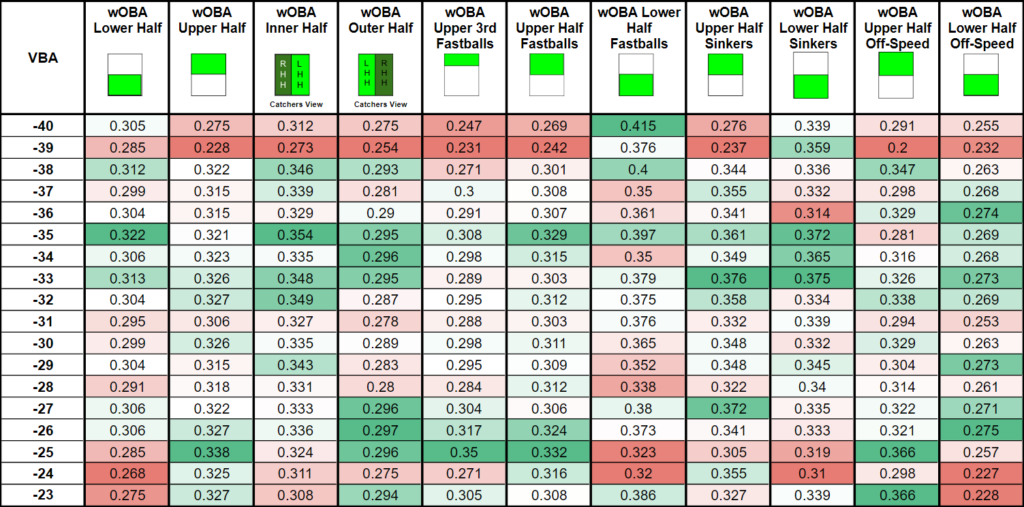
Concluding Notes:
VBA more than anything, is a product of movement and style. Every hitter will be different because their body is shaped and moves much differently. Timing and location of pitches both play a significant role as well because the path will likely come out different based upon if rushed or early. But understanding how a hitter moves and what their average path looks like through the zone can be very valuable for helping to match a certain approach to each hitter.
This data, like everything else in the hitting world, is not a perfect science. Steven Kwan and Luis Arraez fall under the steeper VBA groups that on average make far less contact and strike out more, which we all know is far from true! These two, in my opinion, fall into the bucket of players I mentioned earlier who tend to be very good at adjusting the height of their hands/posture to allow themselves to make contact with these pitches. This is likely where we also see the decrease in exit velocity for these hitters because they are fighting the natural rotational acceleration of the swing. This goes back up to my speed/exit velocity note above. (Like I said there, many times when I’ve worked on adding bat speed with hitters in my experience we have flattened out the swing a little bit). But does that mean that what Kwan and Arraez are doing is bad? Absolutely not! These two are extremely successful because of their ability to put the ball in play and create the higher BABIP because of their ability to get the ball into the outfield. It’s hard to say if this success would translate if they did add more speed because that speed could possibly mean a slightly flatter path that maybe doesn’t produce the same results (but very well also could not). So would this trade off be worth it in the end? We probably will never know.
I want to reiterate this again, there is not one style that is the best way. Hitting is all individual and finding what allows each hitter to be on time consistently, while also being adjustable and then matching that with a plan in the box. This is what I believe produces the best hitters.
So when it comes to the game, is it smarter to adjust the path/posture to account for different pitchers? Or should they stick with their natural path/movement and we adjust the plan/approach to match it? Or is it a little of both? That’s the number one question in regards to understanding and utilizing VBA in the hitting world in my opinion. Every hitter is different and how can we maximize their production on the field from what they have.
To all my fellow coaches and to our hitters, I hope you can take something away from this. Use it to help your understanding but not as the be all and end all when it comes to coaching your own, or someone else’s swing. BE ON TIME AND BE ADJUSTABLE!
*Last note: Both flat and steep VBA bat paths can be adjustable!*
Thanks for reading, I just want to help hitters reach and have success at the highest level. If you want specific hitter VBA’s you’ll have to sign up for a SwingGraphs account yourself. Definitely worth it if you want to do your own research and get access to their research articles.

